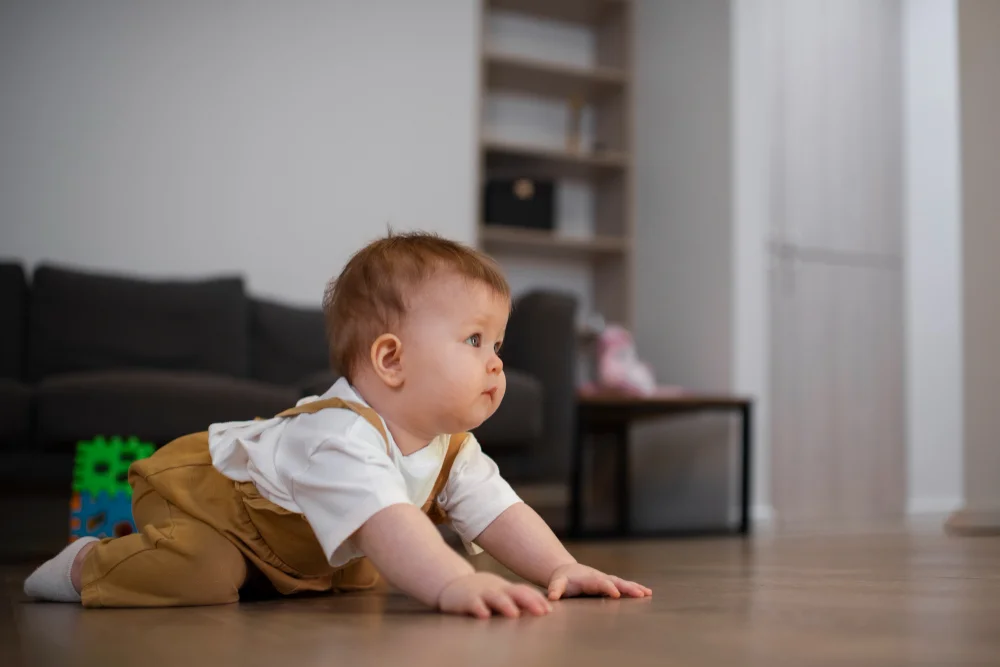“Have you ever seen the sheer joy on a baby’s face when they roll over for the first time?” It may look like a simple movement, but that tiny twist holds a world of developmental significance. I remember the moment my niece first rolled from her tummy to her back—her eyes widened in surprise, and then she laughed. That giggle wasn’t just adorable; it was a sign of something profound: her brain and body were working in harmony.
As a physiotherapy student working with early intervention therapists, I’ve come to realise that rolling is far more than a cute milestone. It’s a gateway to motor coordination, spatial awareness, muscle strength, and cognitive growth. But unfortunately, many caregivers underestimate its value, often focusing more on flashier milestones like crawling or walking.
Let’s explore why rolling matters so much and what you can do to support this vital stage of your baby’s development.
What Is Rolling, and When Does It Typically Occur?
Rolling is one of the earliest gross motor milestones, usually occurring between 4 to 6 months of age. It involves a baby moving from tummy to back or back to tummy—both of which require distinct muscle coordination.
Tummy-to-Back Rolling
Typically the first to appear, this motion requires the baby to push up using their arms, turn their head, and shift their weight.
Back-to-Tummy Rolling
This usually follows, demanding more advanced trunk control and stronger core muscles.
While timelines vary, consistent opportunities for tummy time and free movement help promote healthy motor development.
Why Rolling Matters: The Foundations of Development
1. Muscle Strength and Core Stability
Rolling helps babies build the foundational strength needed for future skills. According to Dr. Tanya Altmann, a paediatrician and author of Baby and Toddler Basics, rolling exercises neck, shoulder, and trunk muscles—key areas for sitting, crawling, and eventually walking.
“Rolling promotes balanced muscle development across both sides of the body, which is essential for later coordinated movements,” says Dr. Susan Klein, a paediatric physiotherapist based in the UK.
2. Bilateral Coordination and Brain Development
Bilateral coordination—using both sides of the body together—is developed during rolling. This enhances communication between the brain’s hemispheres, which supports skills like writing, reading, and problem-solving later in life.
3. Sensory Integration and Spatial Awareness
Rolling stimulates the vestibular system, which helps babies understand balance, motion, and spatial orientation. When babies roll, they begin to comprehend how their body moves through space—crucial for developing body awareness and coordination.
4. Cognitive and Emotional Growth
That tiny roll can also be empowering. A baby learns they can control their environment, which fosters confidence and curiosity.
In a 2019 study published in Infant Behaviour and Development, researchers found that infants who met gross motor milestones earlier showed increased engagement and exploratory behaviour compared to peers who reached milestones later.
Common Challenges and Misconceptions
Many parents worry if their baby isn’t rolling by a certain age. However, it’s important to consider a few factors:
- Reduced Floor Time: Babies who spend excessive time in car seats, bouncers, or swings often have fewer chances to explore movement.
- Fear of Tummy Time: Some caregivers avoid tummy time because their baby dislikes it, not realising its vital role in strengthening rolling muscles.
- Comparisons: Comparing one baby to another can lead to unnecessary worry. Genetics, birth history, and temperament all influence when rolling occurs.
“Focus less on the calendar and more on the opportunity,” advises Jenni Oates, an early childhood physiotherapist. “Create a space for movement, and skills like rolling will follow.”
How to Encourage Rolling: Practical Tips for Caregivers
1. Tummy Time Is Non-Negotiable
Start with short periods as early as newborn age. Gradually increase the time as the baby gets more comfortable.
2. Use Toys for Motivation
Place a favourite toy just out of reach. This encourages reaching, shifting weight, and eventually rolling.
3. Mirror Play
Babies are fascinated by their reflection. Placing a baby-safe mirror beside them during tummy time can promote head turns and body twists.
4. Minimal Restriction
Limit the use of swings, carriers, or seats during awake time. Encourage floor play on safe surfaces.
5. Model the Movement
Gently guide the baby through the rolling motion. Use soothing tones and eye contact to make it a fun interaction.
“Think of it as a dance rather than a drill,” says Oates. “Babies thrive on responsive, joyful movement.”
Personal Insight: A Clinical Placement Experience
During my paediatrics placement, I worked with a six-month-old boy who hadn’t begun rolling. His parents were concerned, but after observing their daily routine, we found the baby spent nearly all his awake time in a reclined seat.
We designed a simple plan: tummy time after each nappy change, floor play three times a day, and a toy rotation system to keep things fresh. Within two weeks, he rolled for the first time. The relief and excitement on his parents’ faces were unforgettable.
This wasn’t a miracle—it was about creating consistent, safe opportunities for movement.
Frequently Asked Questions (FAQs)
When should I worry if my baby isn’t rolling?
If your baby isn’t attempting to roll by around 6–7 months, it’s wise to consult a paediatrician or physiotherapist for guidance.
Can early rolling be a concern?
If a baby rolls unusually early (before 3 months), it could be a sign of heightened muscle tone or reflex patterns. Best to get a professional opinion.
Is back-to-tummy rolling more important?
Both directions matter. Back-to-tummy requires more core strength, but tummy-to-back builds essential neck and upper body control.
How often should I practice tummy time?
Start with 3–5 minutes, 3 times a day, and gradually increase as the baby tolerates more.
Final Thoughts: Why Rolling Deserves More Attention
Rolling may not get as many social media likes as a baby’s first steps, but it is a cornerstone of physical and neurological development. From strengthening muscles to boosting brain function, this often-overlooked milestone sets the stage for everything that follows.
As someone immersed in physiotherapy and early development, I urge every caregiver to see rolling for what it truly is—not just a milestone, but a masterpiece in motion.
Have you noticed any fun or unexpected moments during your baby’s rolling journey? Share them in the comments below or talk to your paediatric therapist about ways to enhance floor play. Every roll counts.




